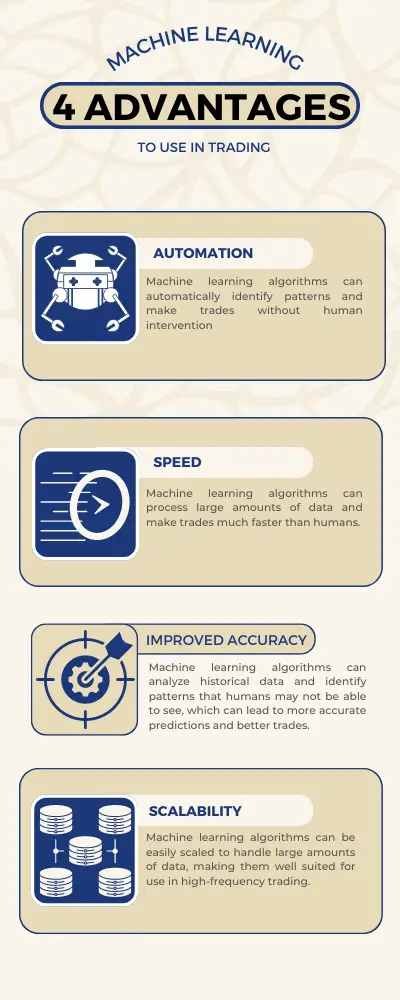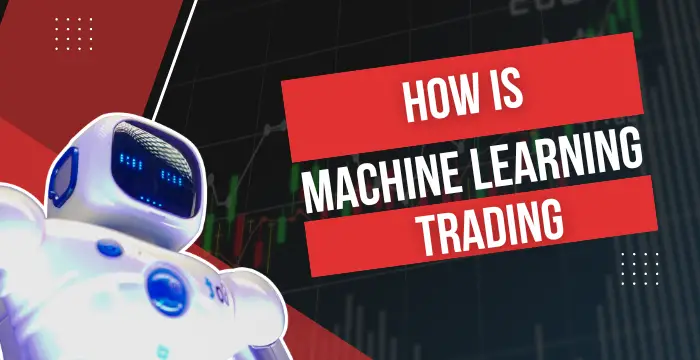Over the past six decades, AI and machine learning have made fantastic progress, evolving from science fiction to reality in the 21st century. Although these technologies are still considered in the early stages of development, they have made numerous contributions in various fields, such as data analysis, the economy, and business. Many individuals worldwide continue to study and develop machine learning to take it to the next level, broadening the range of applications beyond what is currently possible.
Did you know machine learning can also be applied to trading, including in the stock market, forex, and commodities? This article will explore how machine learning can aid traders in executing orders in the market.
Can Machine Learning be Used for Trading?
Before delving deeper, it is important to understand what machine learning truly is. Machine learning (ML) is closely associated with AI as it was the starting point for AI development, but it has since evolved into its field. ML refers to AI systems capable of self-learning based on algorithms and historical data.
Because of its ability to process historical data using specific algorithms, it is clear that machine learning can be applied to trading. It's because trading is closely related to technical analysis, where traders must utilize historical data on the price movement of an asset. However, it's not just price movement data that can be analyzed but also important news that can impact market sentiment.
It is important to note that trading is not only based on rational factors that affect prices but also on environmental factors, political conditions, psychological dynamics, and the economy. All of these can result in fluctuations in the market. Experts have attempted to develop machine learning to predict series by analyzing price movements over a certain period, for example, using machine learning to make buying or selling decisions over the past ten years, and the level of accuracy is quite high.
Advantages of Using Machine Learning in Trading

It is undeniable that you can manually observe the market; even that can be much better if you are consistent. However, the market is constantly changing, so sometimes classical analysis could be more optimal to apply. Machine learning is here to solve these complex problems with its algorithmic trading. The advantages of using machine learning in trading include the following:
Asset Price Predictions
Machine learning will use training data in the system and then predict price movements in an asset, such as stocks. Machine learning will use predictor variables to predict the target variable.
That will be very helpful for stock traders in making investment decisions that they will make in the future.
Accelerate the Search for Effective Algorithmic Trading Strategies
Machine learning will evolve by looking for the most effective algorithm strategy to be implemented in the market. Since machine learning is so synonymous with automation techniques, it's clear that it will be more useful than the traditional approach.
This effective algorithmic strategy will help traders to optimize their trading so that the maximum profit can be obtained by minimizing the large risks involved.
Number of Markets That Can Be Monitored Increases
As a trader, you usually won't be able to monitor all the markets, 1-2 markets maximum for the average person. If many markets are monitored, it will usually impact the quality of our decisions, where the risks that will be borne will be much greater.
Machine learning solves the problem that machine learning can monitor different types of markets at the same time. Of course, it will increase the opportunities received by a trader.
How Machine Learning Is Used for Trading
As discussed above, machine learning can help a trader make investment decisions. Then how exactly can machine learning be utilized in trading?
Sentiment analysis
Machine learning experts have experimented with predicting stock trading results by combining sentiment analysis, chart analysis, and reinforcement learning methods. Machine learning acts as an indicator that analyzes significant news and articles from leading news agencies or those circulating on social media and then correlates all of that with buying or selling data collected through reinforcement learning.
The entire machine learning development process requires considerable resources and time, but the results have been worth it. Many institutions such as banks, hedge funds, and social trading platforms are using this type of machine learning.
Trading Signals
A trader can also take advantage of machine learning to receive trading signals, but it's important to remember that these signals should be followed with further manual analysis. Trading signals from machine learning only serve as notifications to traders to alert them of potential opportunities in the market.
Ultimately, it is up to each trader to make decisions as every trader has different risk tolerance, investment outlook, time horizon, and trading strategy. Therefore, the trader makes the final decisions, not machine learning.
In general, machine learning is created by analysts by considering a large number of metrics from various sources in a short period of time. Currently, machine learning can analyze almost all historical data and produce accurate signals for a long-term perspective.
High-Frequency Trading
High-Frequency Trading (HFT) is complex algorithmic trading. The computer will execute a relatively large number of orders in just a few seconds to generate profits from very small price differences.
Of course, humans cannot do these actions because, indeed, that is something that only machine learning can do. Machine learning will make large data entries with fast and accurate calculation capabilities.
Unfortunately, not all traders can do HFT at the moment. This is for several reasons, such as:
- It requires a computer with a complex algorithm and very high speed.
- The hardware is expensive, and only big companies can afford it.
- Your trading computer should be placed as close to the server as possible because machine learning has to work as accurately.
How Can You Use Machine Learning for Trading
Over time, many people have come to understand the importance of investing. They hope to benefit from the increase in the price of an asset from time to time.
Stocks are a favorite instrument for many people for short-term and long-term investments. Of course, stocks also come with their risks, just like other assets, such as a price drop or the company's liquidation risk.
Therefore, it is important for traders to minimize this risk by analyzing stock price movements at any time. Since the movement in stocks is nonlinear, traders need a method that can help them monitor price movements.
Machine learning is here to help. As a trader, there are several methods that can be applied to take advantage of machine learning.
1. Support Vector Regression for Stock Market Index
A researcher from Gunadarma University uses the Support Vector Regression (SVR) algorithm. He uses hyperparameter tuning to use the grid research method to determine the optimal hyperparameter for SVR.
Based on the SVR research results, machine learning can produce good predictive and generalization abilities. For the assessment of this study, the Root Mean Squared Error (RMSE) and Mean Absolute Percentage Error (MAPE) values were used, where RMSE produces training and testing of 14,334 and 20,281, while MAPE produces training and testing values of 0.211% and 0.251%.
The results of this study are expected to assist traders in determining whether the stock market's performance at that time is experiencing an increase or decrease and can assist in decision-making.
2. Using Neural Networks
The neural network is a machine learning process called deep learning that uses nodes or neurons connected in a layered structure that resembles the human brain.
Neural networks create adaptive systems that computers use to learn from their mistakes and improve on them continuously. Therefore, artificial neural networks try to solve complex problems, one of which is predicting the price movement of an asset.
Intelligent decisions can be made because neural networks can learn and model the relationship between input and output data which is nonlinear and complex. In contrast, previously, it was also discussed that stock prices move non-linearly and are very complex.
3. Extreme Learning Machine (ELM)
ELM is included in the single-layer feedforward neural network (SLFN), where input weight values and bias are generated randomly. The advantage of ELM is its fast training time compared to other algorithms, such as SVR and Backpropagation. The stages in ELM include normalization, training, testing, denormalization, and evaluation. In stock analysis, it is usually known as the parameters that are usually present in daily stock data: Open, High, Low, and Price.
Open is the stock price at the time the trade is opened, High is the highest price of a stock on a trading day, Low is the lowest price of a stock on a trading day, and the price is the stock price at the time the trade is closed. The results of research conducted by several researchers resulted in the lowest MAPE value of 1.012% using the sigmoid activation function, the number of neurons in the hidden layer was four neurons, and the data used was data from the last year.

